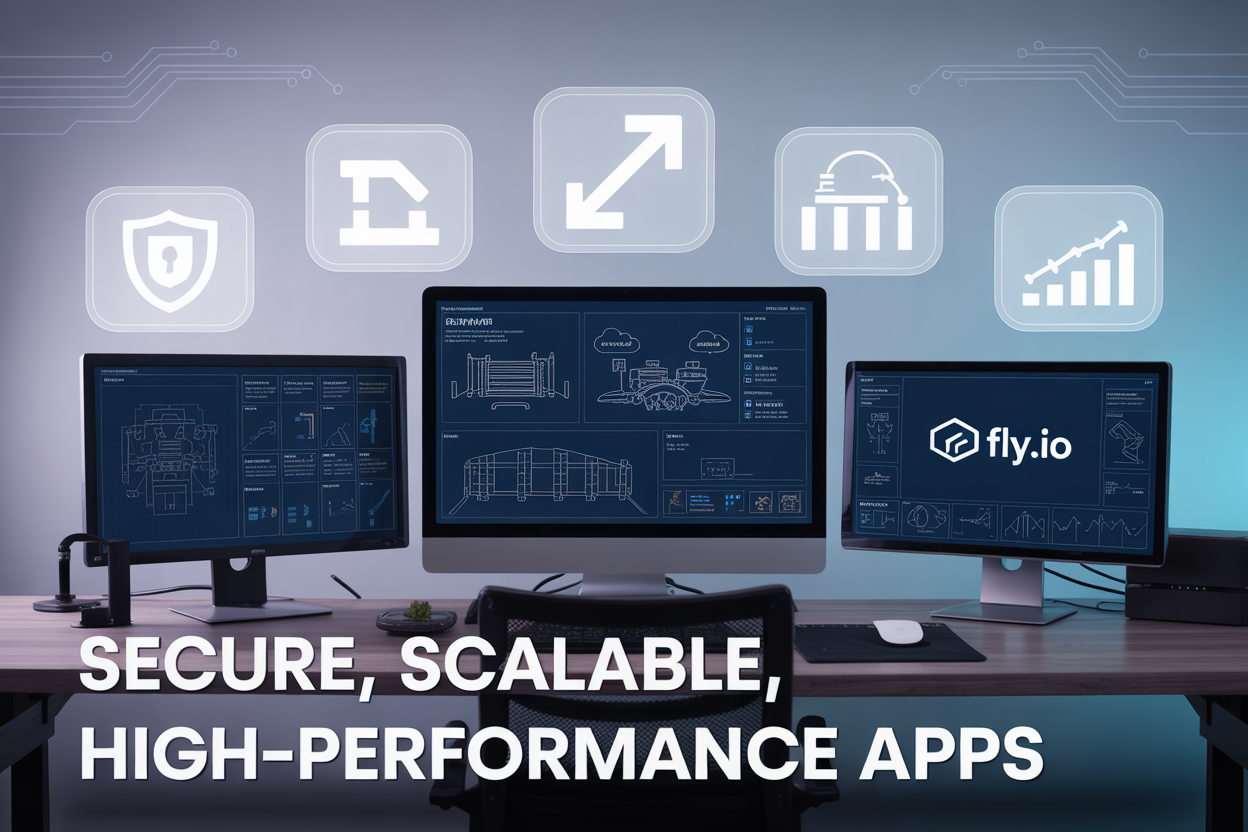Modern developers need reliable cloud platforms that won’t break under pressure or expose security holes. If you’re building web applications and want to deploy confidently on Render, Railway, or Fly.io, this guide breaks down the Render Railway Fly.io best practices that separate successful deployments from costly failures.
This comprehensive cloud platform deployment guide targets full-stack developers, DevOps engineers, and tech leads who need to make smart platform choices and implement bulletproof deployment strategies. You’ll learn how to build scalable web app architecture that handles traffic spikes without crashing your budget.
We’ll walk through platform selection criteria that help you pick the right service for your specific needs, then dive deep into security implementation strategies that protect your applications from common vulnerabilities. You’ll also discover performance optimization techniques and CI/CD deployment strategies that streamline your development workflow while maintaining rock-solid reliability.
By the end, you’ll have actionable knowledge for creating high-performance web applications that scale smoothly and stay secure across any of these three powerful platforms.
Platform Overview and Selection Criteria

Key differences between Render, Railway, and Fly.io architectures
Each cloud platform deployment guide reveals distinct architectural approaches that shape how your applications perform and scale. Render operates on a traditional container orchestration model with automatic builds triggered from Git repositories. The platform abstracts infrastructure complexity while providing managed PostgreSQL, Redis, and static site hosting under a unified dashboard.
Railway takes a more developer-centric approach with instant deployments directly from GitHub repositories. Their architecture emphasizes simplicity with built-in databases, environment variable management, and automatic HTTPS certificates. Railway’s edge lies in its streamlined developer experience, making it exceptionally easy to go from code to production.
Fly.io stands apart with its distributed edge computing architecture. Applications run on lightweight VMs called “machines” that can be deployed across multiple regions simultaneously. This microservices deployment patterns approach allows for geographic distribution of your application logic, bringing compute closer to users for reduced latency.
The fundamental difference lies in compute models: Render uses containers in centralized regions, Railway provides simplified container deployment with managed services, while Fly.io distributes VM instances globally. Each architecture influences how you structure scalable web app architecture decisions and impacts everything from database connections to session management.
Cost analysis and pricing models for each platform
Understanding pricing structures helps optimize cloud hosting comparison decisions for long-term sustainability. Render follows a straightforward tiered pricing model starting with a generous free tier for static sites and basic web services. Paid plans begin at $7/month for web services with 512MB RAM, scaling to enterprise levels with custom pricing.
Railway operates on a credit-based system where you pay for actual resource consumption. The free tier includes $5 in monthly credits, with additional usage billed at $0.000463 per GB-hour for memory and $0.000231 per vCPU-hour. This usage-based model benefits projects with variable traffic patterns but requires careful monitoring to avoid unexpected costs.
Fly.io pricing centers around VM resources with a pay-as-you-go structure. The free tier includes 3 shared-cpu-1x VMs with 256MB RAM each, plus 160GB of outbound data transfer. Additional resources start at approximately $1.94/month per shared VM, with dedicated CPU options scaling higher.
| Platform | Free Tier | Entry Paid Plan | Billing Model |
|---|---|---|---|
| Render | Static sites + 750 hours | $7/month web service | Fixed monthly tiers |
| Railway | $5 monthly credits | Usage-based beyond credits | Pay-per-resource consumption |
| Fly.io | 3 VMs + 160GB transfer | $1.94/month per VM | Pay-as-you-go |
Cost optimization varies significantly based on application patterns. Render suits predictable workloads, Railway benefits intermittent applications, and Fly.io excels for globally distributed services.
Performance benchmarks and deployment speed comparisons
Real-world performance optimization techniques reveal measurable differences across platforms. Cold start times vary dramatically: Render typically initializes containers within 10-30 seconds, Railway achieves similar performance with 15-25 second cold starts, while Fly.io’s VM architecture often delivers faster 5-15 second initialization due to its lightweight machine model.
Deployment speed measurements show Railway leading with sub-minute deployments for most applications, thanks to intelligent caching and streamlined build processes. Render follows closely with 2-4 minute average deployment times depending on build complexity. Fly.io deployments range from 1-5 minutes but benefit from zero-downtime deployments across multiple regions simultaneously.
Geographic performance varies significantly. Fly.io’s distributed architecture delivers superior global performance with sub-100ms response times when applications are deployed near users. Render and Railway, operating from fewer regions, may experience 200-500ms latencies for distant users but provide consistent performance within their coverage areas.
Database connection performance shows interesting patterns. Railway’s integrated database solutions eliminate network hops, providing sub-5ms query times. Render’s managed databases perform well within the same region but may experience 20-50ms latencies across regions. Fly.io’s approach allows database co-location with application VMs, achieving optimal performance for read-heavy workloads.
Throughput benchmarks indicate Fly.io handles concurrent requests most efficiently due to its VM isolation, while Render and Railway’s container models may experience resource contention under extreme loads.
Developer experience and ease of use evaluation
The developer experience directly impacts secure application development velocity and team productivity. Railway excels in simplicity with its GitHub integration automatically detecting frameworks and configuring appropriate build settings. Environment variables, database provisioning, and domain management happen through an intuitive web interface that requires minimal configuration knowledge.
Render provides a balanced approach between simplicity and control. The platform offers clear documentation and predictable deployment workflows while exposing enough configuration options for complex applications. Blueprint files allow infrastructure-as-code practices, making team collaboration more manageable.
Fly.io demands more technical expertise but rewards developers with unprecedented control over application deployment. The flyctl CLI tool provides powerful features for managing distributed applications, but the learning curve is steeper. Advanced features like multi-region deployments and custom networking require deeper infrastructure understanding.
Documentation quality varies across platforms. Render maintains comprehensive guides covering most use cases with clear examples. Railway’s documentation focuses on getting started quickly but sometimes lacks depth for complex scenarios. Fly.io provides extensive technical documentation but assumes higher baseline knowledge.
Community support and troubleshooting resources differ significantly. Railway’s Discord community offers rapid responses for common issues. Render provides traditional support channels with good response times. Fly.io’s community forums contain valuable discussions about advanced deployment scenarios but may require more patience for responses.
The debugging experience shows clear distinctions. Railway provides real-time logs and metrics in a clean interface. Render offers similar monitoring capabilities with integration options for external services. Fly.io’s distributed nature makes debugging more complex but provides detailed VM-level insights for performance analysis.
Security Implementation Strategies

Environment Variable Management and Secrets Handling
Protecting sensitive data across Render, Railway, and Fly.io requires robust environment variable management strategies. Each platform offers secure methods for handling secrets, but implementation varies significantly.
Render provides encrypted environment variables through its dashboard with automatic SSL encryption. Create environment groups to manage shared configurations across multiple services. Group related variables by function (database, API keys, third-party services) and apply consistent naming conventions like DB_CONNECTION_STRING or STRIPE_SECRET_KEY.
Railway offers project-level and service-level environment variables with built-in encryption. Use Railway’s variable references to share common configurations between services while maintaining security boundaries. Their recent addition of secret scanning helps detect accidentally committed credentials.
Fly.io uses fly secrets for sensitive data and regular environment variables for non-sensitive configuration. Secrets are encrypted at rest and in transit, accessible only to running applications. Use flyctl secrets set for database passwords and API keys, while standard environment variables work for feature flags and configuration options.
Best practices across all platforms include:
- Never hardcode secrets in source code or configuration files
- Implement secret rotation schedules for database passwords and API keys
- Use different secrets for staging and production environments
- Monitor secret access patterns and set up alerts for unusual activity
- Apply the principle of least privilege when granting access to sensitive variables
SSL Certificate Configuration and HTTPS Enforcement
Modern web applications require proper SSL/TLS implementation to ensure secure data transmission. All three platforms handle certificate management differently, requiring platform-specific approaches.
Render automatically provisions SSL certificates for all custom domains through Let’s Encrypt. Certificate renewal happens automatically without intervention. Enable HTTPS redirect at the service level to force all traffic through encrypted connections. Configure HSTS headers in your application to prevent protocol downgrade attacks.
Railway provides automatic SSL certificates for both generated domains and custom domains. Their certificate management integrates seamlessly with DNS providers, making setup straightforward. Enable the “Force HTTPS” option in service settings to redirect HTTP traffic automatically.
Fly.io offers automatic certificate provisioning through their edge network. Configure certificates using flyctl certs add your-domain.com and let their global load balancer handle SSL termination. Their edge locations provide faster SSL handshakes by reducing geographical distance between users and certificate validation.
Security headers enhance HTTPS effectiveness:
Strict-Transport-Security: max-age=31536000; includeSubDomains
Content-Security-Policy: default-src 'self'
X-Frame-Options: DENY
X-Content-Type-Options: nosniff
Database Security and Connection Encryption
Database security extends beyond basic password protection, requiring encrypted connections, proper user management, and network-level isolation. Each platform offers different approaches to database security implementation.
Connection encryption should be mandatory across all environments. Configure your database connections to require TLS/SSL encryption, rejecting any unencrypted connection attempts. Use connection pooling solutions like PgBouncer or connection pool libraries that maintain encrypted connections to reduce overhead while preserving security.
Database Access Patterns:
| Platform | Managed Database | Connection Security | Network Isolation |
|---|---|---|---|
| Render | PostgreSQL, Redis | SSL required by default | Private networking |
| Railway | PostgreSQL, MySQL, Redis | TLS encryption available | Private networking |
| Fly.io | Postgres via partner | Wire Guard encrypted | Private IPv6 networks |
Implement database user segmentation with role-based access control. Create separate database users for different application components with minimal required permissions. Production databases should never use administrative accounts for application connections.
Regular security audits should include connection log analysis, user access reviews, and vulnerability assessments. Enable database logging for connection attempts, failed authentications, and privilege escalations.
API Authentication and Authorization Best Practices
Securing API endpoints requires implementing proper authentication mechanisms and granular authorization controls. Modern applications need multiple layers of API security to protect against various attack vectors.
JWT Token Management forms the foundation of stateless authentication. Implement short-lived access tokens (15-30 minutes) paired with longer-lived refresh tokens (7-30 days). Store refresh tokens securely and implement token rotation to minimize compromise impact. Use strong signing algorithms like RS256 for production environments.
OAuth 2.0 Implementation provides standardized authentication flows for third-party integrations. Configure proper redirect URIs, implement PKCE for public clients, and validate state parameters to prevent CSRF attacks. Use authorization code flow for web applications and device flow for IoT or CLI applications.
API Rate Limiting protects against abuse and ensures fair resource usage. Implement sliding window rate limiting with different limits for authenticated and anonymous users. Consider implementing adaptive rate limiting that adjusts based on user behavior patterns and system load.
Request Validation and Sanitization prevents injection attacks and ensures data integrity. Validate all input parameters against defined schemas, sanitize user inputs, and implement proper error handling that doesn’t leak sensitive information.
Cross-platform considerations include consistent authentication middleware, centralized session management, and unified logging for security events. Implement proper CORS policies, validate API keys against allowed origins, and use request signing for high-security endpoints.
Security monitoring should track failed authentication attempts, unusual access patterns, and privilege escalation attempts across all API endpoints.
Scalability Architecture Patterns

Auto-scaling Configuration for Traffic Spikes
Modern applications face unpredictable traffic patterns, making auto-scaling essential for maintaining performance while controlling costs. Render Railway Fly.io best practices emphasize configuring intelligent scaling thresholds that respond quickly to demand changes.
Render’s Auto-scaling Approach:
- Set CPU and memory thresholds between 70-80% for optimal response times
- Configure minimum instances to handle baseline traffic
- Use predictive scaling for anticipated traffic spikes during marketing campaigns
Railway’s Scaling Strategy:
- Leverage horizontal scaling through service replication
- Monitor response times and queue depths as scaling triggers
- Implement graceful shutdowns to prevent request drops during scale-down events
Fly.io’s Regional Scaling:
- Deploy instances across multiple regions for geographic load distribution
- Use Machine API for custom scaling logic based on application-specific metrics
- Configure auto-stop for development environments to minimize costs
| Platform | Scaling Trigger | Min Response Time | Cost Efficiency |
|---|---|---|---|
| Render | CPU/Memory | 2-3 seconds | Good |
| Railway | Queue Depth | 1-2 seconds | Very Good |
| Fly.io | Custom Metrics | <1 second | Excellent |
Database Scaling Strategies and Connection Pooling
Database performance often becomes the bottleneck in scalable web app architecture. Effective connection pooling and scaling strategies prevent database overload while maintaining data consistency.
Connection Pool Optimization:
- Set pool sizes to 10-15 connections per application instance
- Configure connection timeouts between 30-60 seconds
- Use read replicas for query distribution and write operations separation
Horizontal Scaling Techniques:
- Implement database sharding for large datasets across multiple regions
- Use read-only replicas in different geographic locations
- Configure automatic failover mechanisms for high availability
Platform-Specific Database Strategies:
Render:
- PostgreSQL with built-in connection pooling via PgBouncer
- Automatic daily backups with point-in-time recovery
- SSL-only connections for enhanced security
Railway:
- Native PostgreSQL and MySQL support with instant provisioning
- Automatic connection pooling configuration
- Branch-based database environments for testing
Fly.io:
- Distributed SQLite with LiteFS for edge deployments
- PostgreSQL clusters with automatic leader election
- Global database replication for reduced latency
CDN Integration for Global Content Delivery
Content delivery networks dramatically improve application performance by serving static assets from geographically distributed edge locations. Proper CDN integration reduces server load and improves user experience worldwide.
Static Asset Optimization:
- Configure aggressive caching for images, CSS, and JavaScript files
- Use content-based cache invalidation strategies
- Implement automatic asset compression and image optimization
Platform CDN Capabilities:
Render:
- Automatic CDN integration for static sites
- Custom domain support with SSL certificates
- Edge caching with configurable TTL values
Railway:
- Cloudflare integration for enhanced performance
- Automatic asset optimization and compression
- Global edge network with millisecond response times
Fly.io:
- Built-in global network with 30+ regions
- Edge computing capabilities for dynamic content
- Custom edge logic for advanced routing scenarios
Load Balancing and Traffic Distribution Techniques
Effective load balancing ensures even traffic distribution across application instances while maintaining session consistency and handling failures gracefully.
Load Balancing Strategies:
- Round-robin distribution for uniform server utilization
- Weighted routing for servers with different capacities
- Health check configurations to remove unhealthy instances automatically
Session Management:
- Use stateless authentication with JWT tokens
- Implement session storage in Redis or database
- Configure sticky sessions only when absolutely necessary
Traffic Management Features:
| Technique | Render | Railway | Fly.io |
|---|---|---|---|
| Health Checks | HTTP/HTTPS | TCP/HTTP | Custom Scripts |
| Session Affinity | Limited | No | Yes |
| Failover Time | 30-60s | 10-30s | 5-15s |
| Geographic Routing | Basic | Advanced | Excellent |
Microservices Deployment and Orchestration
Microservices deployment patterns enable independent scaling and development of application components. Each platform offers unique approaches to service orchestration and communication.
Service Communication Patterns:
- Use HTTP/REST APIs for synchronous communication
- Implement message queues for asynchronous processing
- Configure service discovery for dynamic endpoint resolution
Deployment Strategies:
- Blue-green deployments for zero-downtime updates
- Canary releases for gradual feature rollouts
- Rolling updates with health check validations
Platform-Specific Microservices Support:
Render:
- Multiple services within single repository
- Environment variable sharing between services
- Integrated logging and monitoring across services
Railway:
- Service templates for rapid microservices deployment
- Built-in service mesh for inter-service communication
- Automatic environment management and secrets handling
Fly.io:
- Docker-based deployments with custom configurations
- WireGuard VPN for secure service-to-service communication
- Advanced networking with custom domains per service
Container orchestration becomes simpler when platforms handle infrastructure complexity, allowing developers to focus on application logic and business requirements. These microservices deployment patterns ensure applications remain maintainable and scalable as teams and requirements grow.
Performance Optimization Techniques

Build Process Optimization and Caching Strategies
Speed matters when deploying on Render, Railway, and Fly.io. Docker layer caching stands as your first line of defense against slow builds. Structure your Dockerfile to place frequently changing components last, allowing unchanged layers to remain cached. Start with dependencies installation, then copy stable configuration files, and finally add your source code.
Multi-stage builds dramatically reduce final image sizes. Use a builder stage for compilation and a production stage with only runtime essentials. This approach cuts deployment times and reduces memory footprint across all three platforms.
Platform-Specific Caching Strategies:
| Platform | Build Cache Feature | Best Practice |
|---|---|---|
| Render | Automatic Docker layer caching | Optimize layer order, use .dockerignore |
| Railway | Build cache with nixpacks | Leverage nixpacks.toml for custom builds |
| Fly.io | Remote Docker builder cache | Use --remote-only for consistent caching |
Package managers offer built-in caching mechanisms. npm’s npm ci beats npm install in production environments. Python’s pip wheel caching and Go’s module proxy reduce dependency resolution time. Mount cache directories during builds to persist these optimizations between deployments.
Database Query Optimization and Indexing
Database performance can make or break your application’s responsiveness. Query optimization starts with understanding your data access patterns. Analyze slow query logs regularly and identify bottlenecks before they impact users.
Index strategy requires balance. Too few indexes slow down reads, while too many impact write performance. Focus on columns used in WHERE clauses, JOIN conditions, and ORDER BY statements. Composite indexes work best when the most selective columns come first.
Essential Indexing Patterns:
- Single-column indexes: Primary keys, foreign keys, frequently filtered columns
- Composite indexes: Multi-column queries, covering indexes for read-heavy operations
- Partial indexes: Filtered data subsets, conditional queries
- Unique constraints: Data integrity with performance benefits
Connection pooling prevents database overload. Configure pool sizes based on your database’s concurrent connection limits. pgBouncer for PostgreSQL and Redis for session storage reduce database pressure significantly.
Query batching and prepared statements minimize round trips. Instead of executing multiple single-record operations, batch them into single queries. Prepared statements also defend against SQL injection while improving performance.
Consider read replicas for read-heavy workloads. All three platforms support database replicas, allowing you to distribute query load effectively.
Memory Management and Resource Allocation
Memory leaks kill performance over time. JavaScript applications particularly suffer from closure-related leaks and detached DOM nodes. Use heap snapshots and profiling tools to identify memory growth patterns.
Memory Optimization Techniques:
- Object pooling: Reuse expensive objects instead of creating new ones
- Lazy loading: Load resources only when needed
- Garbage collection tuning: Configure GC parameters for your runtime
- Memory limits: Set appropriate container limits to prevent OOM kills
Resource allocation varies by platform. Render offers predefined service types, Railway provides flexible resource scaling, and Fly.io allows granular machine configuration. Match your allocation to actual usage patterns rather than guessing.
Monitor memory usage patterns during peak traffic. Vertical scaling (more memory per instance) often proves more cost-effective than horizontal scaling for memory-intensive applications.
Container orchestration benefits from proper resource requests and limits. Set requests based on baseline usage and limits based on peak requirements. This prevents resource starvation while allowing burst capacity.
Asset Compression and Minification
Static assets consume significant bandwidth without proper optimization. Modern compression algorithms like Brotli outperform traditional gzip, reducing transfer sizes by 15-20% on average.
Build-time optimization beats runtime processing every time. Minify JavaScript, CSS, and HTML during your build process rather than serving raw files. Tools like Webpack, Vite, and esbuild handle this automatically with proper configuration.
Asset Optimization Checklist:
- JavaScript: Minification, tree shaking, code splitting
- CSS: Minification, unused rule removal, critical path optimization
- Images: WebP/AVIF formats, responsive sizing, lazy loading
- Fonts: Subsetting, preloading, fallback strategies
Content Delivery Networks amplify your optimization efforts. Render’s global CDN, Railway’s edge caching, and Fly.io’s global deployment all benefit from properly compressed assets.
HTTP/2 and HTTP/3 change bundling strategies. While HTTP/1.1 favored large bundles, newer protocols handle multiple small files efficiently. Consider your target audience’s browser support when choosing bundling approaches.
Service workers enable advanced caching strategies. Cache static assets aggressively while implementing smart invalidation for dynamic content. This reduces server load and improves perceived performance dramatically.
Deployment and CI/CD Best Practices

Git-based deployment workflows and branch strategies
Modern CI/CD deployment strategies rely heavily on well-structured Git workflows that streamline code delivery across Render, Railway, and Fly.io platforms. The GitFlow model provides a solid foundation, using feature branches for development, a develop branch for integration, and main/master for production-ready code. Each platform automatically triggers deployments based on branch configurations.
Railway excels with its GitHub integration, allowing automatic deployments from specific branches. Configure production deployments from your main branch while using staging environments for development branches. Render follows similar patterns, supporting GitHub, GitLab, and Bitbucket repositories with branch-specific deployment rules.
For Fly.io, the flyctl CLI integrates seamlessly with Git hooks, enabling custom deployment triggers. Consider implementing a three-tier branch strategy:
- Feature branches: Individual development work
- Development branch: Integration testing and staging
- Main branch: Production-ready releases
Tag your releases using semantic versioning (v1.2.3) to maintain clear deployment histories. This approach helps track which features are deployed where and simplifies rollback procedures when issues arise.
Automated testing integration before deployment
Testing automation prevents broken code from reaching production and reduces manual oversight burden. All three platforms support pre-deployment testing through various integration points and third-party services.
GitHub Actions works exceptionally well across all platforms. Create workflows that run unit tests, integration tests, and security scans before triggering deployments. Here’s a typical testing pipeline structure:
| Test Stage | Tools | Duration |
|---|---|---|
| Unit Tests | Jest, pytest, RSpec | 2-5 minutes |
| Integration Tests | Cypress, Selenium | 5-15 minutes |
| Security Scans | Snyk, CodeQL | 3-10 minutes |
| Performance Tests | Lighthouse CI | 5-10 minutes |
Railway’s built-in testing capabilities include health checks and deployment verification. Configure custom build commands that include your test suite: npm test && npm run build. Failed tests automatically prevent deployment progression.
Render supports similar pre-build hooks and health checks. Use their build filters to run comprehensive test suites before Docker image creation or static site generation.
Fly.io provides flexibility through custom Dockerfiles where you can include multi-stage builds with testing phases. Add testing steps in your dockerfile that fail the build if tests don’t pass.
Blue-green deployment for zero-downtime updates
Zero-downtime deployments keep your applications available during updates, which is crucial for production services. Blue-green deployment patterns maintain two identical production environments, switching traffic between them during releases.
Fly.io natively supports blue-green deployments through their rolling deployment system. Configure multiple instances and let Fly.io gradually shift traffic to new versions while monitoring health checks. Use fly deploy --strategy rolling for controlled rollouts.
Railway implements blue-green deployments through their preview environments and production swapping mechanisms. Deploy new versions to preview environments, run validation tests, then promote to production with instant traffic switching.
Render achieves zero-downtime updates through their automatic scaling and health check systems. New deployments start additional instances before terminating old ones, ensuring continuous service availability.
Key configuration considerations include:
- Health check endpoints:
/healthor/statusroutes - Graceful shutdown handling: Allow current requests to complete
- Database migration strategies: Run migrations separately from application deployments
- Static asset management: Use CDNs for asset delivery during transitions
Rollback procedures and disaster recovery plans
Quick rollback capabilities save applications when deployments introduce critical issues. Each platform provides different rollback mechanisms that should be tested regularly and documented clearly.
Fly.io offers instant rollbacks through fly releases rollback commands. This reverts to previous working versions within seconds, making it ideal for immediate issue resolution. Maintain release notes and version tags to identify stable rollback targets quickly.
Railway provides rollback functionality through their deployment history interface and CLI tools. Previous deployments remain accessible, allowing instant switching between versions. Use Railway’s environment variable versioning to maintain configuration consistency across rollbacks.
Render supports rollbacks through their dashboard and API, reverting both application code and associated configurations. Their automatic health checks help identify when rollbacks are necessary by detecting service degradation.
Disaster recovery planning extends beyond simple rollbacks:
- Database backups: Schedule regular automated backups across all environments
- Configuration management: Store environment variables and secrets in version control
- Infrastructure as Code: Use Terraform or similar tools for reproducible infrastructure
- Communication protocols: Establish incident response procedures and stakeholder notifications
- Testing schedules: Regularly test rollback procedures in staging environments
Document your rollback procedures with step-by-step instructions, including expected timeframes and verification steps. Create runbooks that team members can follow during high-stress situations, reducing human error and response times.
Monitoring and Maintenance Excellence

Application performance monitoring setup
Setting up comprehensive application monitoring across Render, Railway, and Fly.io requires platform-specific approaches tailored to each provider’s strengths. For Render applications, integrating APM tools like New Relic or Datadog provides deep insights into response times, database queries, and memory usage. The built-in metrics dashboard offers basic monitoring, but external APM solutions deliver the granular data needed for production applications.
Railway applications benefit from Axiom or Grafana Cloud integrations, which can capture custom metrics through environment variables and webhooks. Since Railway automatically provisions infrastructure, monitoring focuses on application-level performance rather than server metrics. Configure custom dashboards to track user sessions, API response times, and background job processing.
Fly.io’s distributed architecture demands specialized monitoring strategies. Use Fly’s built-in metrics alongside tools like Honeycomb or Grafana to track performance across multiple regions. The platform’s edge computing capabilities require monitoring latency between regions and user locations. Set up custom health endpoints that report not just application status but also database connectivity and external service dependencies.
For all platforms, implement distributed tracing to understand request flows across microservices. OpenTelemetry provides vendor-neutral instrumentation that works consistently across different hosting environments. This approach becomes crucial when applications span multiple platforms or integrate with third-party services.
Error tracking and logging implementation
Effective error tracking transforms debugging from reactive firefighting into proactive maintenance. Sentry remains the gold standard across all three platforms, offering real-time error tracking with detailed stack traces and user context. Configure Sentry with custom tags that identify the hosting platform, deployment version, and user segments to accelerate issue resolution.
Structure your logging strategy around different severity levels and categories. Application logs should capture business logic errors, while infrastructure logs track deployment issues and resource constraints. On Render, access logs through the dashboard or redirect them to external services like Papertrail or Logtail for long-term storage and analysis.
Railway’s ephemeral file system requires external logging solutions from day one. Stream logs to services like Better Stack or Grafana Loki to prevent data loss during deployments or container restarts. Configure structured logging with JSON format to enable powerful filtering and search capabilities across log aggregators.
Fly.io applications benefit from the platform’s built-in log shipping to external destinations. Configure multiple log outputs to separate application events from system events. Use Fly’s machine scaling events to trigger alerts when applications restart unexpectedly or encounter resource limits.
Implement contextual logging that includes user IDs, request IDs, and feature flags. This enriched data helps connect errors to specific user journeys and deployment changes, reducing mean time to resolution significantly.
Health checks and uptime monitoring
Robust health checking goes beyond simple ping tests to validate actual application functionality. Design health check endpoints that verify database connectivity, external API availability, and critical business processes. These endpoints should return detailed JSON responses indicating the status of each dependency rather than simple HTTP status codes.
Configure multi-layered monitoring with services like UptimeRobot, Pingdom, or StatusCake to check applications from various global locations. This geographic distribution helps identify regional connectivity issues that might not affect all users. Set up different monitoring intervals based on criticality – every 30 seconds for critical services and every few minutes for less critical endpoints.
Platform-specific considerations matter significantly. Render applications should include checks for static asset availability and CDN performance. Railway deployments need monitoring for build completion and container startup times. Fly.io applications require region-specific health checks to validate edge deployment consistency across multiple locations.
Implement cascading alert strategies that escalate based on failure duration and scope. Configure initial alerts for single-region failures, intermediate alerts for multi-region issues, and critical alerts for complete service unavailability. Include automated remediation where possible, such as triggering deployments or scaling operations when specific health check patterns emerge.
Cost monitoring and resource optimization alerts
Proactive cost management prevents budget surprises and identifies optimization opportunities before they impact performance. Each platform offers different cost structures requiring tailored monitoring approaches. Render’s predictable pricing model benefits from usage pattern analysis to identify opportunities for plan downgrades during low-traffic periods.
Railway’s resource-based billing demands careful monitoring of CPU, memory, and network usage across all services. Set up alerts when resource consumption approaches plan limits or shows unusual spikes that might indicate inefficient code or potential security issues. Configure automated scaling policies that balance performance requirements with cost constraints.
Fly.io’s pay-per-use model requires granular monitoring of machine hours, data transfer, and storage costs across regions. Create cost allocation tags for different environments and features to identify which parts of your application drive the highest expenses. Monitor scaling patterns to optimize machine sizes and regional distribution based on actual usage rather than assumptions.
Implement automated cost optimization through scheduled scaling policies. Configure applications to scale down during predictable low-traffic periods and scale up before expected traffic spikes. This approach works particularly well for B2B applications with clear usage patterns.
Use cloud cost management tools like CloudHealth or native platform dashboards to create custom reports showing cost trends and projections. Set up weekly or monthly cost review processes that compare actual spending against budgets and identify optimization opportunities across all deployed applications.

The modern cloud deployment landscape offers incredible opportunities through platforms like Render, Railway, and Fly.io, but success depends on making smart choices from the start. Getting your platform selection right based on your specific needs, implementing rock-solid security measures, and designing for scale from day one will save you countless headaches down the road. Performance optimization isn’t just about speed—it’s about creating experiences that keep users engaged and coming back.
Building great apps on these platforms comes down to following proven patterns and staying disciplined about your processes. Set up proper CI/CD pipelines, monitor everything that matters, and never treat maintenance as an afterthought. Your users deserve applications that are fast, secure, and reliable, and these platforms give you all the tools you need to deliver exactly that. Start with these best practices, adapt them to your unique situation, and watch your applications thrive in production.




















